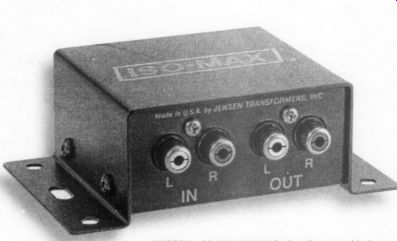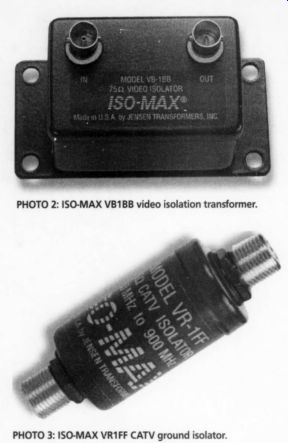The ISO-MAX Audio Video Isolator Kit consists of a CL-2RR isolator for stereo audio ($170), a VB-1BB isolator for composite video ($100), a VR-1FF isolator for CATV or FM ($50), a pair of BNC-to-RCA adapters ($5), a pair of TA-R1 audio test adapters and troubleshooting guide ($10), and a foam-lined carrying case. The kit sells for $299. An optional VS-1SS isolator for S-video adds $136. The kit and individual items are available from: Jensen Transformers, Inc, 7135 Hayvenhurst Ave., Van Nuys, CA 914006, 818-374 5857, jensen-transformers.com.
By CH
The isolators contain high-quality Jensen audio or video isolation transformers. A troubleshooting guide is included, with seven very useful topics, written by Bill Whitlock:
. Dynamic Range and Noise Basics
. Unbalanced Interface Basics
. Power Line and Grounding Effects in Real-World Systems
. Troubleshooting System Interfaces
. Systems with Multiple Grounds
. When to Add a Ground Connection
. More Tips to Reduce Noise
One of the most important tips is never to use devices such as three-prong to two-prong AC plug adapters (ground lifters) to solve a noise problem. Audio, video, and other cables that interconnect equipment can carry lethal voltages throughout the system if just one "ground lifted" device fails.
When I first received the Jensen ISO MAX items, I wondered where I would find occasion to use them. The opportunity came almost immediately.

PHOTO 1 -- ISO-MAX CL2RR dual audio ground isolator.
Audio Application
While testing a vacuum tube preamp/amplifier combination, I ran into a hum problem. There was a very low-level hum from the right channel. However, the left channel had sufficient hum to be notice able from a couple feet away. While it was acceptably quiet 6" from the speakers, I set about trying to find the source of the louder left-channel hum.
I tried moving the interconnects around relative to the AC power cords and speaker cables, and swapped all interconnects and cables, as well as the input and output signals from left to right. I disconnected all sources, and tried different locations in my power out let array for the two power cords-no change in the left-channel hum level.
I could minimize the hum by removing either end of the left-channel inter connect. The hum was independent of the preamp-input selector, the volume control setting, and even whether or not the preamp's AC power cord was plugged in. I did not attempt to lift the AC safety ground with a "cheater" plug, since I believe this is a dangerous practice. I did measure the chassis-to-chassis resistance, which was less than 0.1 ohm.
This is the point at which the Jensen ISO-MAX arrived for review. Working backward from the power amplifier and following the Jensen troubleshooting instructions, I used the isolator and adapters to try to find the source of the left-channel hum. When I installed the Jensen CL-2RR dual audio ground isolator (Photo I) between the tube amp and preamp, the hum dropped to an undetectable level in both channels.
Video Application
The video problem occurred with a Radio Shack 15-1119 four-way distribution amplifier, which consists of an AC powered transistor RF (50-400MHz) amplifier that feeds four VCR/VHF/CATV outputs. The input is isolated from the outputs, which are interconnected at the secondary of a small RF transformer. I connected the 15-1119 to feed my cable signal to a TV and two VCRs, which are further interconnected via RCA audio video cables for dubbing.
The problem manifested itself as video "herringbone" patterns at a very low beat frequency. When I removed the 15-1119 and replaced it with a high-quality TVC three-way splitter, the problem went away, although I now had 7dB attenuation at each output.
I used the VB-1BB baseband video isolator (Photo 2) to try to isolate the problem. Since the VB-1BB has BNC connectors and the cable TV connections use RG/6 coax with F connectors, I needed a set of Radio Shack 278-251 F-to-BNC adapters for some of the tests. For the other tests, I used the BNC-to-phono adapters provided with the Iso-Kit.
Working backward from the TV, and again following the troubleshooting instructions, I used the isolator and adapters to locate the source of the her ringbone noise problem. It turned out to be the audio-video cable connection be tween the two VCRs. I could also eliminate the problem by disconnecting either the coax input or the RCA AV interconnects at the older VCR.

Photo 2: ISO-Max VB-1BB baseband video isolator. PHOTO 3: ISO-MAX VR1FF CATV
ground isolator.
Conclusion
The various ISO-MAX isolators proved to be enormously helpful in locating real world ground loops between the audio amp/preamp, the two VCRs, and in the following FM tuner/antenna setup. Additional items for Professional Audio applications are available, such as a micro phone, "direct box," and pro-to-consumer adapters.
FM Radio Application
- By E.T.Dell
A new Yagi antenna installed on my house held promise not only of reception of Boston's TV stations, but also the added signal strength for my FM tuner.
Boston's offerings are especially rich in good music from WGBH in particular, and WCRB when you prefer a background of wallpaper classics. When 1 was finally able to cable a connection to the tuner from the splitter serving the TV, the loud growl of a very nasty 60Hz hum in my system's right channel sent me racing for the tuner on/off switch.
What I had, of course, was a ground loop.
At about this same time, a representative for Jensen Transformers called to ask whether the magazine would be interested in reviewing the kit, which introduces this review. One of the units in the kit sounded like an answer to my problem and one that might solve it.
Inserting the VR-1FF single-channel CATV RD isolator (Photo 3) into the 75-ohm line dramatically solved the problem with no noticeable signal loss. The manufacturer's specifications indicate that there is a 0.35dB insertion loss. The antenna's gain, however, is strong enough to provide plenty of signal, even at 80 air miles distance from Boston's transmitter farm in Newton, Mass.
I could detect no residual hum in either left or right channel after inserting the Jensen isolation transformer. Although the almost $50 price tag for the device may seem pricey to some, it solves the problem for which it was de signed and can easily be considered a "high end" product. Jensen has earned an enviable reputation as a manufacturer of the highest-quality transformer products in the world. The VR-1FF confirms that reputation.
Although I would not wish to cause problems for Jensen, the best thing about this kit, despite the excellent and probably unique quality level of the hard ware, is the highly informative booklet that accompanies it. I don't know whether the ten-page document can be made available separately, but it is a model of clarity concerning grounding problems in systems: audio, video, and much else. Bill Whitlock offers a clear re view of grounding basics, which every audiophile should be clear about. And this is especially true as we move into an era when many will be attempting to marry video and audio systems.
Manufacturer's Response:
Under "Video Application," it appears that the re viewer used the composite video isolator at a point in the system where the signals were VHF or CATV. The appropriate isolator for this would be our model VR-1FF, which would not require the adapters he bought at Radio Shack. Finally, concerning Edward Dell's closing paragraph, we would like to note that the troubleshooting guide is indeed available separately; it is a free down load from our website as a pdf document.
3. Bill Whitlock President Jensen Transformers, Inc.
Manufacturer's Specifications:
CL-2RR Dual Audio Ground Isolator
Bandwidth: -3dB at 0.25Hz to 50kHz
Input: 7V RMS at 20Hz, 11V RMS at 30kHz
Input impedance: 49k when driving typical
47K inputs, 1kHz +4dBu
Insertion loss: -1dBmax
Magnitude response, ref 1kHz: -0.15dB 20Hz min; ~1dB 20kHzmin.
Deviation from linear phase (DLP): +2° 20Hz to 20kHz, +4dBu
Distortion: <0.001% typical, 1kHz; 0.04% typical20Hz; +4dBu
Maximum 20Hz input level: +17dBu min, 1%THD
Common-mode rejection ratio (CMRR): typically 95dB at 60Hz, 85dB at 3kHz
Output impedance: 4k65, 1kHz DC resistance: typically 2k26 input, 1k90 output
Capacitance: 105pF, 1kHz input-to-output
Allowable source impedance (driving CL-2RR): zero to 2k
Allowable load impedance (loading CL-2RR): 10k min.
Allowable load capacitance (cable and circuit loading CL-2RR): zero to 100pF
Input to output voltage difference: 24V RMS, 34V peak max.
VB-1BB 75-ohm
Video Isolation Transformer
Insertion loss: -0.7dB max
Differential gain: 0.05% max at 3.85MHz
Differential phase: 0.05% max at 3.85MHz
Luminance nonlinearity: 0.2%max
Bandwidth: -3dB at 10Hz to 10MHz
Input VSWR: 1.2 max 1kHz to 8MHz, 1.065 max at 3.85MHz
Common-mode rejection ratio (CMRR): 100dB min at 60Hz
DC resistance: typically 2.61 ohm input and output
Capacitance: 1n94, 1kHz input-to-output; 35pF input or output to case
Input to output withstanding voltage: 350V RMS at 60Hz
Also see: